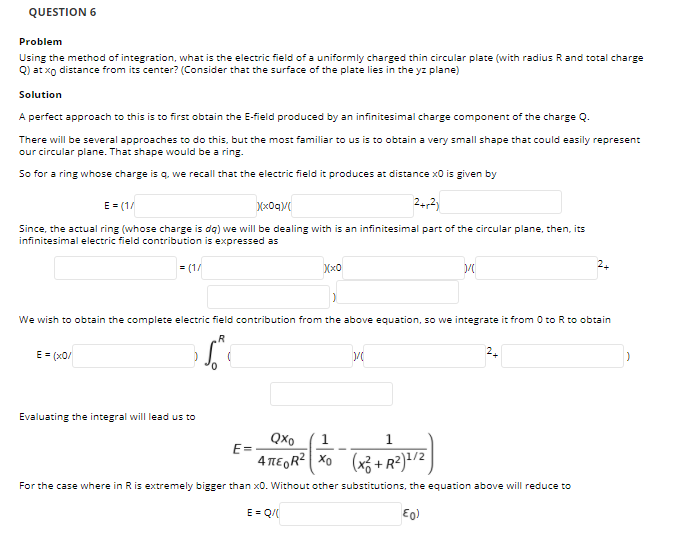Problem Using the method of integration, what is the electric field of a uniformly charged thin circular plate (with radius Rand total charge Q) at xo distance from its center? (Consider that the surface of the plate lies in the yz plane) Solution A perfect approach to this is to first obtain the E-field produced by an infinitesimal charge component of the charge Q. There will be several approaches to do this, but the most familiar to us is to obtain a very small shape that could easily represent our circular plane. That shape would be a ring. So for a ring whose charge is q, we recall that the electric field it produces at distance x0 is given by E- (1/ 2,2) Since, the actual ring (whose charge is dq) we will be dealing with is an infinitesimal part of the circular plane, then, its infinitesimal electric field contribution is expressed as 2. = (1/ Xx0 We wish to obtain the complete electric field contribution from the above equation, so we integrate it from 0 to R to obtain .R E- (x0/ Evaluating the integral will lead us to Qxo E=- 4 TEGR? Xo (x3 + R?)=/2 1 1 For the case where in R is extremely bigger than x0. Without other substitutions, the equation above will reduce to E= Q/ Eg)
Problem Using the method of integration, what is the electric field of a uniformly charged thin circular plate (with radius Rand total charge Q) at xo distance from its center? (Consider that the surface of the plate lies in the yz plane) Solution A perfect approach to this is to first obtain the E-field produced by an infinitesimal charge component of the charge Q. There will be several approaches to do this, but the most familiar to us is to obtain a very small shape that could easily represent our circular plane. That shape would be a ring. So for a ring whose charge is q, we recall that the electric field it produces at distance x0 is given by E- (1/ 2,2) Since, the actual ring (whose charge is dq) we will be dealing with is an infinitesimal part of the circular plane, then, its infinitesimal electric field contribution is expressed as 2. = (1/ Xx0 We wish to obtain the complete electric field contribution from the above equation, so we integrate it from 0 to R to obtain .R E- (x0/ Evaluating the integral will lead us to Qxo E=- 4 TEGR? Xo (x3 + R?)=/2 1 1 For the case where in R is extremely bigger than x0. Without other substitutions, the equation above will reduce to E= Q/ Eg)
Chapter5: Electric Charges And Fields
Section: Chapter Questions
Problem 101P: In this exercise, you practice electric field lines. Make sure you represent both the magnitude and...
Related questions
Question

Transcribed Image Text:QUESTION 6
Problem
Using the method of integration, what is the electric field of a uniformly charged thin circular plate (with radius Rand total charge
Q) at xo distance from its center? (Consider that the surface of the plate lies in the yz plane)
Solution
A perfect approach to this is to first obtain the E-field produced by an infinitesimal charge component of the charge Q.
There will be several approaches to do this, but the most familiar to us is to obtain a very small shape that could easily represent
our circular plane. That shape would be a ring.
So for a ring whose charge is q. we recall that the electric field it produces at distance x0 is given by
E= (1/
Mx0qV
242)
Since, the actual ring (whose charge is dg) we will be dealing with is an infinitesimal part of the circular plane, then, its
infinitesimal electric field contribution is expressed as
= (1/
Xx0
2.
We wish to obtain the complete electric field contribution from the above equation, so we integrate it from 0 toR to obtain
.R
E= (x0/
2.
Evaluating the integral will lead us to
QXo
1
1.
E=
4 TEGR2 Xo (x3 + R²)!/2
For the case where in Ris extremely bigger than x0. Without other substitutions, the equation above will reduce to
E = Q/
Expert Solution
This question has been solved!
Explore an expertly crafted, step-by-step solution for a thorough understanding of key concepts.
Step by step
Solved in 4 steps with 1 images

Knowledge Booster
Learn more about
Need a deep-dive on the concept behind this application? Look no further. Learn more about this topic, physics and related others by exploring similar questions and additional content below.Recommended textbooks for you

